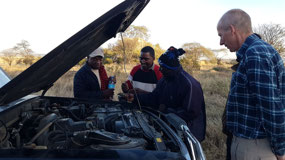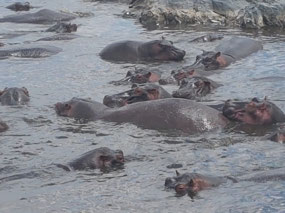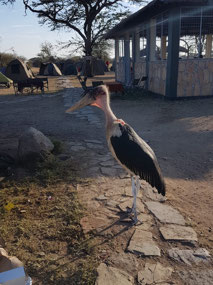I get up early to check the car. Battery is as dead as a door nail. We have jump cables, and I ask a guide if he can help me start the car. With my limited Shwahili I manage to make friends and within 15 minutes, 4 guides are helping me and not only starting the car, but also bending the clamps of the roof rack, so they cannot fly off again.
But after running the engine for ten minutes, the car still doesn't start. One of the two batteries is bad. We start the car with cables again, and i receive instructions on how to find a garage in town.
With Chruus I drive over the dusty bad roads to the garage. My hope for quickly buying a new battery evaporates when I see the garage has only equipment to fix tires. A mechanic who doesn't speak english is sure the problem is caused by poor contacts, and drives a nail between the contact ring and the battery pole. I have to start the car... and it starts! The mechanic starts a celebration dance but I am not convinced. I wait ten seconds and start the car again, and it cannot start.
No more dancing. The mechanic starts to do things even I could do myself (check the liquid in the batteries), and I soon realize i know more about the problem than he does.
We call the owner of the car, and tonight they will deliver two new batteries. Our trip to the north really becomes doubtful now.
We fill up the tank and return to the campsite, while never turning off the engine.
That's how the rest of the day we explore the Serengeti. We see hundreds of Thompson gazelle, many Grant gazelle, impalas, even austriches. But also a large pool full of hippopotamus, which move, argue, bellow, and smell badly, for there must be about forty including young ones, in a small area of the river.
I talk to a German lady who now lives in New Zealand, who is on an organized tour. She tells me she was inn Massai Mara (Kenya) to see the migration of the Wildebeest, but found it 'too much': 200 safari landcruisers, jockeying for a space to take the best picture of the Wildebeest crossing the river. Guides trying to control their clients, who demanded to leave the car (after paying so much money I have the right to get a better position to take pictures !).
She did not enjoy it.
We see elephants, giraffes, water buffalo and lots of other animals before we return to camp, just as we get a message that Moses and mtoto have arrived with the batteries.
They install the batteries, and I use the opportunity to fix an attachment to the exhaust pipe, and we re-attach the front license plate which had fallen off.
We are intrigued how Moses and ntoto came here so fast, and Moses teaches us, that with these bad roads, you have to drive real slow or real fast.
We ask him to demonstrate, and to our amazement, he drives 70 and 80 km per hour over the gravel and the holes. Unbelievable the car doesn't break, everything is rattling and shaking, and the car sometimes bounces over the road. It's impossible to talk, for the noise is deafening. But we have learned something.
They eat with us and leave after dark for a hostel for Tanzanians (much cheaper than for foreigners).
Tired, but satisfied, we go to sleep.

 Seronera, Mara Region, Tanzania
Seronera, Mara Region, Tanzania








2025-05-23